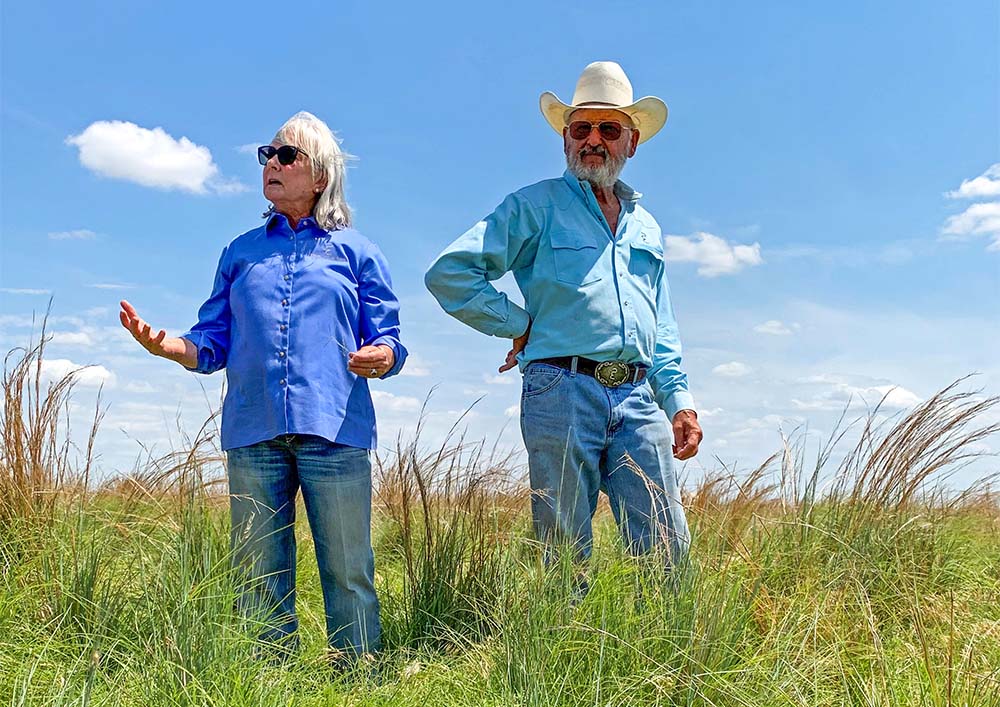
Photo by Janet Hunter
On a late June afternoon, Emry Birdwell listens as Deborah Clark explains to visitors why their pastures are lush during a prolonged drought. The native grass they’re standing in has not been grazed for several months.
When Deborah Clark and Emry Birdwell started dating 30-some years ago, he took her out to his ranch one evening to introduce her to his pride and joy — his cattle herd.
Former classmates, she’d built a career in her family’s telecommunications business; he was a third-generation North Texas rancher.
“I didn’t know a thing about cattle,” Clark says, “but when Emry began talking about holistic ranching, that got my attention.
“He had me at ‘holistic.’”
Herd impact works
Today, the wife-and-husband team operates an 11,800-acre ranch near Henrietta, Texas, where they raise about 5,000 stockers on native pasture. Since buying the Clay County ranch in 2004, they’ve proved it’s possible to regenerate the land through holistic management practices.
The couple’s approach centers on adaptive rotational grazing and herd impact. By pasturing all 5,000 head of cattle together at the same time in the same field — an impressive sight for their frequent visitors — they’re rebuilding their soil and improving their forage diversity.
The ranch is divided into 350 paddocks, ranging from 45 to 145 acres in size. Depending on forage growth, they move the herd three to six times a day to fresh pasture. After a paddock is grazed, it rests for at least 75 days. No paddock is grazed more than twice a year.
“We manage grass before we manage cattle,” Birdwell says. “And we manage soil before we grow grass.”
Soil comes first
The science behind the strategy is simple, Birdwell and Clark explain. To profitably produce healthy cattle, it takes a variety of nutrient-dense grasses and forbs. To produce the forages abundantly, the soil needs deep, rich organic matter that holds moisture. And the best way to increase organic matter is through intensive livestock grazing. The animals’ hoof action works manure and grass residue into the soil and loosens deeply buried native grass seed. It’s a process that mimics the action of bison herds centuries ago.
“It’s not about the grass they eat, it’s how much they knock down to form the plant litter, which becomes organic matter,” Birdwell says. “That organic matter stops water from running off. The litter holds water, protects the ground from evaporation and keeps the ground cool – and that’s good for nesting birds.
“It’s all holistic; it all connects.”
Native grasses return
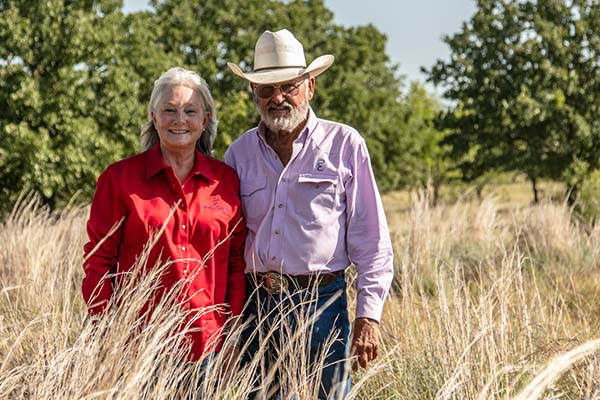
Photo by Wyman Meinzer,
courtesy of Texas Agricultural Land Trust
More than 60 species of native grasses, forbs and legumes thrive on the Birdwell and Clark Ranch.
The couple has witnessed the rebirth of their tallgrass prairie rangeland.
“We haven’t planted one seed here, but we have all the native grasses represented, and there’s almost no bare ground,” Birdwell says proudly.
More than 60 species of grasses, forbs and legumes have replaced what was a monoculture of little bluestem nearly 19 years ago. Now the cattle enjoy a smorgasbord of buffalograss, Indiangrass, sedges, gramas, tridens, switchgrass, vetch, clovers and other perennials — including eastern gamagrass, a warm-season bunch grass that’s generally disappeared over the years.
One of the couple’s most significant accomplishments is the reduction of bare ground from 25% to just 5%.
“The fact we’ve covered up that bare ground is proof that what we’re doing is right,” Birdwell says.
Beef per acre increases
There are other achievements, too. The ranch typically produces 100 to 120 pounds of beef per acre, more than double the county average of 40 to 50 pounds, Clark reports.
Additionally, habitat improvement has helped boost wildlife populations, including white-tailed deer, Rio Grande turkey, bobcats, eagles, bobwhite quail and the Texas horned toad.
That’s not all.
Thanks to the ability of the deep-rooted native grasses to capture carbon dioxide from the atmosphere and sequester it in the soil, Birdwell and Clark recently started selling carbon credits.
A lifelong rancher, Birdwell became interested in holistic managed grazing in the 1980s through the teachings of Allan Savory, an internationally renowned advocate of holistic resource management. Ranching on leased and family-owned land at the time, Birdwell couldn’t fully implement a rotational grazing plan.
So, when he and Clark purchased their current ranch with Capital Farm Credit as their financing partner, he could finally apply the lessons he’d learned from Savory.
Drought teaches useful lessons
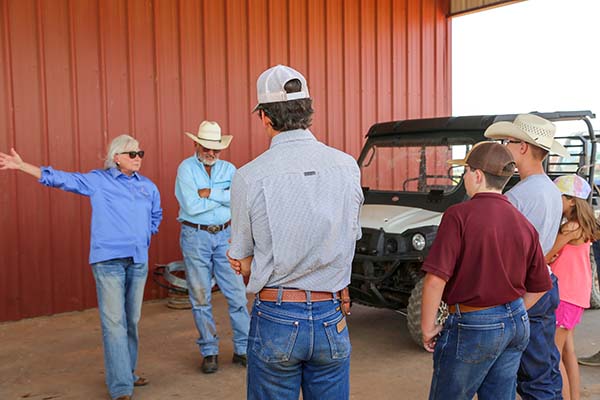
Photo by Janet Hunter
Deborah Clark and Emry Birdwell discuss their rotational grazing system with local FFA members. Rural youth groups are among the many organizations that visit the ranch each year.
Initially, Birdwell and Clark managed their herd in three groups of 1,500 to 1,800 stockers, rotating them through multiple paddocks. Then the drought of 2011 hit, and most of the pastures ran out of water.
“The drought forced us to do two things right,” Birdwell says. “It forced us to go to one herd, and it forced us to improve our water.”
With technical assistance from the Natural Resources Conservation Service, the couple installed 25 miles of polyethylene pipe to deliver water to pastures across the ranch. Birdwell designed a mobile water trough made from a propane tank cut in half lengthwise that connects to water valves in the paddocks. The system has allowed them to fence off riparian water sources where the cattle once drank.
Next, they consolidated the cattle into one herd to increase the impact of dense grazing. At the same time, they expanded the number of pastures but made them smaller.
“We remembered what Emry’s teacher Allan Savory advised: ‘When you’re in a drought, group your cattle together,’” Clark says.
Restocking starts over
The couple starts to assemble a new herd every September, buying stockers according to weather, markets and how well their pastures are regenerating. In November, they place about 2,000 stockers on leased wheat pasture, then combine the entire herd of more than 6,000 head to graze on their own ranch during winter and early spring. Come May, some are shipped to pastures in Kansas, and in July all of the cattle go to feedlots for finishing.
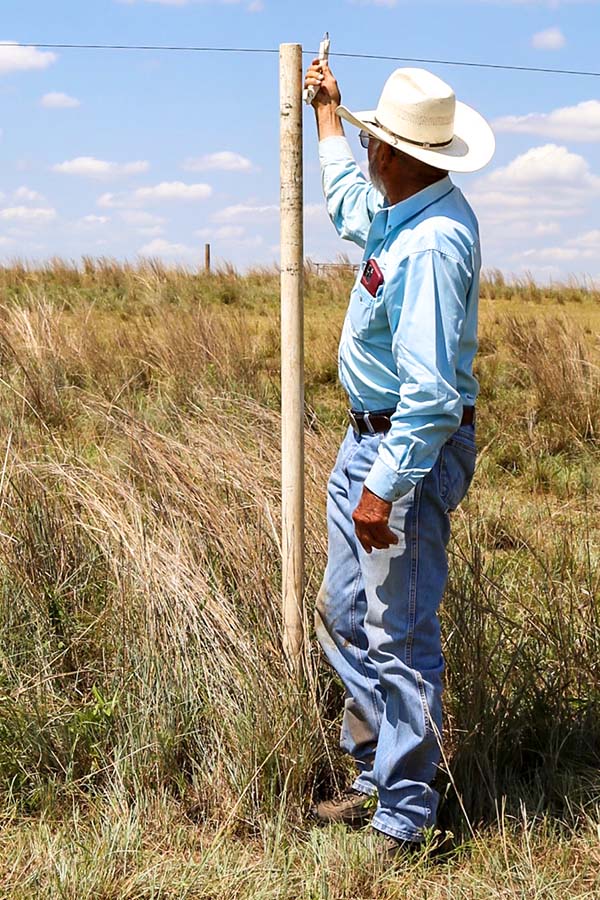
Photo by Janet Hunter
Emry Birdwell raises an electric fence wire to rest on a PVC T-post, allowing cattle to cross from one paddock to the next. The system eliminates the need for gates between his 350 paddocks.
Key to Birdwell and Clark’s rotational system are 140 paddocks, which are divided into 350 paddocks during the fast-growing seasons and separated by electric polywire. The wire is easily raised at T-posts to allow the cattle to mosey through to the next paddock at their own pace.
“It takes the stress off moving the cattle,” Clark says. Plus, one person can move the entire herd alone, and just three or four people are able to handle all the day-to-day chores.
The exception is at shipping time. Even then, it’s a calm operation. Cowboys on horseback quietly nudge the cattle toward the ranch’s own scales, where the animals are weighed and quickly loaded onto trucks, about 1,000 head an hour. This minimizes stress, which can cause 1% shrinkage for every hour the cattle are penned.
“We practice low-stress cattle handling,” Birdwell says. “We don’t want a bunch of cowboys whooping and hollering.”
Ranch earns national recognition
For its efforts to regenerate prairie rangeland, restore riparian waterways and improve wildlife habitat, the Birdwell and Clark Ranch has received numerous awards. These include the Lone Star Land Steward Award from Texas Parks and Wildlife and the Environmental Stewardship Award, Texas Division, from the National Cattlemen’s Beef Association.
Birdwell and Clark also are recognized nationally and internationally as leaders in holistic ranching. As a certified trainer with Holistic Management International, Clark frequently speaks at workshops and conferences, and every year they host scores of visitors, from college students to ranching organizations.
But some of their favorite activities involve youth education and wildlife. These include the Texas Youth Hunting Program, high school and college classes and the Dove Salute, an annual hunt they host for Sheppard Air Force Base personnel.
“Emry and Deborah are outstanding leaders in the community and extremely generous about sharing their knowledge with others,” says Will Myers, relationship manager in Capital Farm Credit’s Wichita Falls branch. “Capital Farm Credit is honored to support their work to restore this land for future generations. It’s been a joy to watch the grasslands come alive under their management. They truly exemplify the term ‘land steward.’”
But caring for the land is more than a passion for the couple.
“This land is a gift we’ve been given,” Clark says. “It’s our responsibility to take care of it — not just to sustain it, but to improve and regenerate it.”
— Staff
Visit birdwellandclarkranch.com for more information.
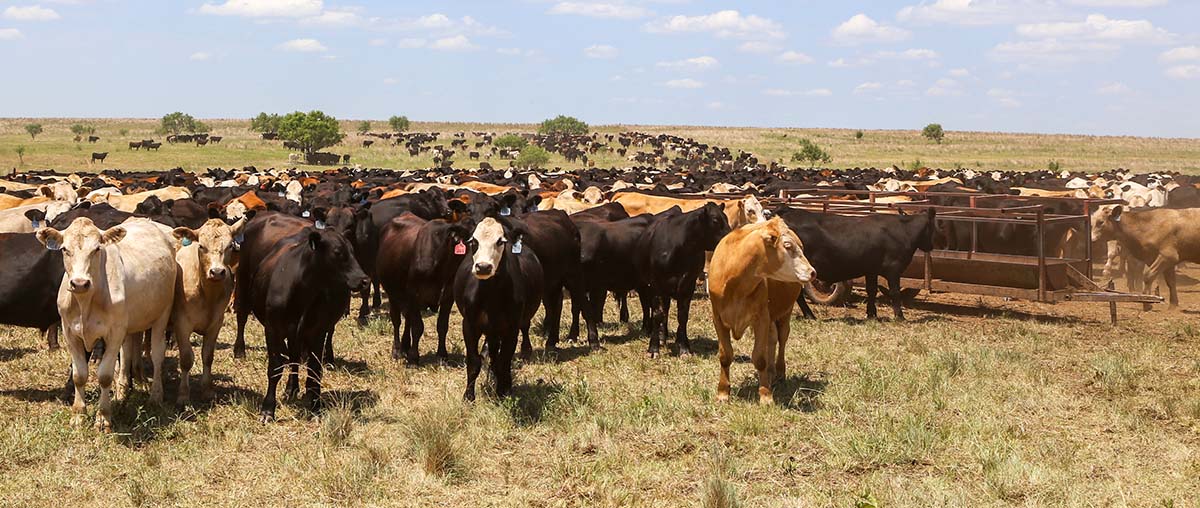
Photo by Janet Hunter
Stocker cattle gather near the mobile water trough Emry Birdwell designed. After grazing in this paddock most of the day, they are ready to move to a fresh pasture. The water trough will be moved with them.
Conservation easement brings peace of mind
Emry Birdwell woke up one morning last year and told his wife, Deborah Clark, he’d had his best sleep in 18 years.
The day before, the couple had made the critical decision to place their 11,800-acre North Texas ranch in a conservation easement.
“Both of us have a strong and intense goal to leave this ranch intact,” Clark says. “We were concerned about succession planning and making sure that our three children won’t have to sell the place to pay estate taxes.”
They had another goal, too. After devoting nearly two decades to regenerating their soils and native prairie grasses, they wanted to ensure their stewardship work continues.
Under a conservation easement, that can happen.
Preserving the ranch
In September 2022, the couple signed an agreement with the Texas Agricultural Land Trust that reflects their desire for the land to continue to be operated in a regenerative manner — whether it stays in the family or is eventually sold.
A conservation easement is a voluntary legal agreement between a landowner and the “holder” of the easement, permanently restricting certain uses of the land in order to protect its conservation value.
Birdwell and Clark chose to partner with the Texas Agricultural Land Trust (TALT), a private nonprofit organization formed in 2007 by the Texas Farm Bureau, the Texas Wildlife Association and the Texas and Southwestern Cattle Raisers Association. One of more than 30 conservation easement managers in the state, TALT aims to preserve the Texas heritage of agricultural lands, wildlife habitats and natural resources.
“What made TALT work for us is their mission to keep working agricultural land in private hands,” Clark says. In other words, she explains, the land doesn’t have to become a park or greenspace — it can remain a working ranch.
The couple found a conservation easement attractive for other reasons, as well. It would protect the land from being sold for development without restricting how their children could use the ranch.
Creating a living legacy
For Birdwell, peace of mind comes from knowing his work to holistically manage the rangeland can continue.
“Right now, this ranch is only a fraction of what it can be,” he says. “But if the next generation on the ranch keeps progressing, it will be better than any monument to us could ever be. A living legacy is what we’re looking at, and not only for Deborah and me but for her parents and my parents and the cowboys who came before us.”
A primer on conservation easements
Purposes
- Protect open land or habitat from development
- Preserve traditional land use by allowing farming, ranching or timber harvesting activities to continue
- Conserve land that has scenic, biodiversity or other value for recreation or education
- Safeguard a culturally or historically significant structure or area
Tax benefits
- Reduce estate taxes. A conservation easement removes the land’s development potential, which reduces the property’s market value. As a result, heirs will pay lower estate taxes, which may make it easier to keep the land in the family.
- Reduce property and income taxes. Lowering the land value lowers the property taxes. If the conservation easement is permanent, was donated to a land trust for conservation purposes, and meets certain IRS conditions, it can qualify as a tax-deductible charitable donation. This, in turn, can reduce the landowner’s income taxes. The value of the donation is the difference between the property’s market value before it’s put into the easement and the value after the development restrictions are put in place.
For more information, read Texas Land Trends: Conservation Easements in Texas (pdf), published by the Texas A&M Natural Resources Institute.
— Staff
Healthy soil earns carbon credits
Emry Birdwell and Deborah Clark’s efforts to improve their soil and rangeland isn’t just paying off in more beef per acre — now it’s paying off in carbon credits, too.
In December 2021, the couple received their first “carbon check” from Grassroots Carbon, a San Antonio, Texas-based carbon broker. Under a 15-year commitment, they’ll receive annual payments until 2035.
Carbon credits are a medium of exchange used to “offset” carbon dioxide emissions under cap and trade guidelines set by the 2015 Paris Agreement on climate change. Companies that strive to reduce their carbon footprint may opt to pay others, such as farmers and ranchers, for removing carbon from the atmosphere.
How it works
“For us, it’s been a painless process,” Clark says, recounting the steps involved in selling their new cash crop.
In the spring of 2021, Grassroots Carbon visited the North Texas ranch and took more than 80 soil samples, each a meter deep, as well as forage samples. The soil was analyzed for existing carbon content. Then the ranch was verified and certified in the carbon sequestration program — steps required annually.
After five years, the soil will be resampled to measure increase in carbon content. Future credits will be determined by the increase. Meanwhile, Birdwell and Clark received their initial prepayment based on a forward-looking assessment of their soil type, climate and management practices.
Carbon brokers like Grassroots Carbon coordinate and manage deals between landowners who sequester carbon and large carbon-emitting corporations that want to purchase carbon offsets.
The fluctuating carbon credit market is driven by supply and demand. A study by Purdue University’s Center for Commercial Agriculture, published in 2021, found prices offered to farmers ranged from $10 to $20 per metric ton of carbon sequestered.
Grazing and pasture lands sequester from less than 0.3 metric tons (MT) to nearly 3.0 MT of carbon per acre, depending on agricultural activities and management practices, according to a 2022 report by S&P Global. Cropland generally sequesters much less. Sustainable practices such as rotational grazing, regeneration of native perennial grasses, cover cropping and zero tillage help increase carbon sequestration in the soil.
While Clark says they hope their carbon storage payments will help pay off their land loan with Capital Farm Credit, she stresses that sequestering carbon is not about the money.
“Carbon credits are an incentive for the landowner to want to continue to practice in a regenerative way,” she says.
Research before signing
Before signing a contract to sell carbon credits, one should exercise caution and do their research, warns Tiffany Dowell Lashmet, agricultural law specialist with Texas A&M AgriLife Extension Service.
“No two carbon contracts are the same. Contracts offered by brokers differ drastically, and landowners should carefully read the contract and ensure they understand all of the terms prior to signing,” Dowell Lashmet says. “I also always recommend enlisting an attorney licensed in your jurisdiction before signing on that contract’s dotted line.”
— Staff